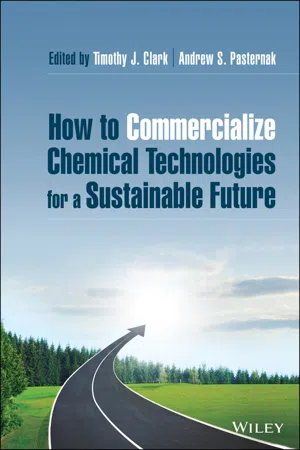
How to Commercialize Chemical Technologies for a Sustainable Future
- English
- ePUB (mobile friendly)
- Available on iOS & Android
How to Commercialize Chemical Technologies for a Sustainable Future
About this book
The definitive guide for scientific entrepreneurs commercializing sustainable technologies in the chemical sector
Lacking the considerable resources of multinational chemical companies, entrepreneurs face a unique set of risks and challenges. How to Commercialize Chemical Technologies for a Sustainable Future is targeted at innovators who are embarking on the entrepreneurial path with their sustainable chemical technology but are unsure of what steps to take. This first-of-its-kind resource features contributions from a diverse team of expert authors, including engineers, venture capitalists, marketing specialists, intellectual property professionals, regulatory experts, industry practitioners, and many others.
Accessible and highly practical, this real-world guide covers each step of the technology commercialization process, from market landscape analysis and financing to scale-up and strategic partnering. Throughout the book, effective tactics and strategies for growing a new venture are supported by case studies highlighting the economic and environmental impact of successful commercialization, and identifying the common mistakes that lead to lost opportunities. Filled with invaluable advice and actionable steps, this book:
- Uses valuation concepts, tools, and examples to demonstrate that for a chemical technology to be sustainable it must not only have market value but also confer benefits to human well-being and the environment
- Offers templates and tools for understanding what customers need, who the competition is and how to successfully differentiate your product to those customers
- Describes how to practically advance your technology from conception all the way to commercial demonstration
- Presents advantages and disadvantages of strategic partnering from the perspective of the start-up and the larger industrial partner, along with strategies to mitigate risks within a partnership
- Provides an overview of the legal regulatory requirements for bringing new chemicals to market in several key geographic regions, as well as the impact of public policy on commercialization
- Offers insights and practical strategies on intellectual property management, raising investment, and operationalizing a startup company
How to Commercialize Chemical Technologies for a Sustainable Future is essential reading for budding entrepreneurs in chemistry, materials science, and chemical engineering looking to bring their sustainable technologies to market. It is also a valuable reference for investors, policymakers, regulators, and other professionals.
Frequently asked questions
- Essential is ideal for learners and professionals who enjoy exploring a wide range of subjects. Access the Essential Library with 800,000+ trusted titles and best-sellers across business, personal growth, and the humanities. Includes unlimited reading time and Standard Read Aloud voice.
- Complete: Perfect for advanced learners and researchers needing full, unrestricted access. Unlock 1.4M+ books across hundreds of subjects, including academic and specialized titles. The Complete Plan also includes advanced features like Premium Read Aloud and Research Assistant.
Please note we cannot support devices running on iOS 13 and Android 7 or earlier. Learn more about using the app.
Information
1
Introduction
1.1 What Is This Book About?
- Awareness and information on the many steps required to commercialize a sustainable chemical technology
- Guidance for making appropriate strategic choices when creating and subsequently growing a new venture
- Motivation and inspiration via success stories of early‐stage companies that have been effectively passing through the various stages of technology commercialization
1.2 What Is a Sustainable Chemical Technology?
Table of contents
- Cover
- Table of Contents
- Title Page
- Copyright
- Dedication
- List of Contributors
- 1 Introduction
- Part I: Laying the Foundation
- Part II: Political and Environmental Considerations
- Part III: Springing into Action
- Part IV: Success Stories
- Index
- End User License Agreement